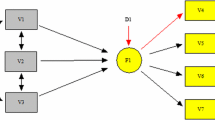Abstract
In theory, the greatest lower bound (g.l.b.) to reliability is the best possible lower bound to the reliability based on single test administration. Yet the practical use of the g.l.b. has been severely hindered by sampling bias problems. It is well known that the g.l.b. based on small samples (even a sample of one thousand subjects is not generally enough) may severely overestimate the population value, and statistical treatment of the bias has been badly missing. The only results obtained so far are concerned with the asymptotic variance of the g.l.b. and of its numerator (the maximum possible error variance of a test), based on first order derivatives and the asumption of multivariate normality. The present paper extends these results by offering explicit expressions for the second order derivatives. This yields a closed form expression for the asymptotic bias of both the g.l.b. and its numerator, under the assumptions that the rank of the reduced covariance matrix is at or above the Ledermann bound, and that the nonnegativity constraints on the diagonal elements of the matrix of unique variances are inactive. It is also shown that, when the reduced rank is at its highest possible value (i.e., the number of variables minus one), the numerator of the g.l.b. is asymptotically unbiased, and the asymptotic bias of the g.l.b. is negative. The latter results are contrary to common belief, but apply only to cases where the number of variables is small. The asymptotic results are illustrated by numerical examples.
Similar content being viewed by others
References
Alizadeh, F., Haeberly, J.-P., Nayakkankuppam, M.V., Overton, M.L., & Schmieta, S. (1997). SDPPACK (Version 0.9 BETA) [Computer software]. New York: Authors. (http://cs.nyu.edu/cs/faculty/overton/sdppack/sdppack.html)
Bentler, P.M. (1972). A lower-bound method for the dimension-free measurement of internal consistency.Social Science Research, 1, 343–357.
Bentler, P.M., & Woodward, J.A. (1980). Inequalities among lower bounds to reliability: with applications to test construction and factor analysis.Psychometrika, 45, 249–267.
Bonnans, J.F., & Shapiro, A. (2000).Peturbation analysis of optimization problems. New York: Springer-Verlag.
Browne, M. W. (1974). Generalized least squares estimators in the analysis of covariance structures.South African Statistical Journal, 8, 1–24.
Cronbach, L.J. (1951). Coefficient alpha and the internal structure of tests.Psychometrika, 16, 297–334.
Cronbach, L.J. (1988). Internal consistency of tests: Analyses old and new.Psychometrika, 53, 63–70.
Della Riccia, G., & Shapiro, A. (1982). Minimum rank and minimum trace of covariance matrices.Psychometrika, 47, 443–448.
Guttman, L. (1945). A basis for analyzing test-retest reliability.Psychometrika, 10, 225–282.
Jackson, P.H., & Agunwamba, C.C. (1977). Lower bounds for the reliability of total scores on a test composed of nonhomogeneous items: I: Algebraic lower bounds.Psychometrika, 42, 567–578.
Rao, C.R. (1973).Linear statistical inference and its applications. New York: Wiley.
Rockafellar, R.T. (1970).Convex analysis. Princeton, NJ: Princeton University Press.
Shapiro, A. (1982). Rank-reducibility of a symmetric matrix and sampling theory of minimum trace factor analysis,Psychometrika, 47, 187–199.
Shapiro, A. (1997). First and second order analysis of nonlinear semidefinite programs,Mathematical Programming, Series B, 77, 301–320.
Socan, G. (1999, July).Bias in some lower bounds to reliability in medium-sized samples (poster presentation). 11th European Meeting of the Psychometric Society, Lüneburg, Germany.
ten Berge, J.M.F., & Zegers, F.E. (1978). A series of lower bounds to the reliability of a test.Psychometrika, 43, 575–579.
ten Berge, J.M.F., Snijders, T.A.B., & Zegers, F.E. (1981). Computational aspects of the greatest lower bound to reliability and constrained minimum trace factor analysis.Psychometrika, 46, 201–213.
Vandenberghe, L., & Boyd, S. (1996). Semidefinite programming,SIAM Review, 38, 49–95.
Verhelst, N.D. (1998).Estimating the reliability of a test from a single test administration (Measurement and Research Department Report 98-2). Arnhem: CITO.
Woodhouse, B., & Jackson, P.M. (1977). Lower bounds for the reliability of the total score on a test composed of nonhomogeneous items: II: A search procedure to locate the greatest lower bound.Psychometrika, 42, 579–591.
Author information
Authors and Affiliations
Corresponding author
Additional information
This research was supported by grant DMI-9713878 from the National Science Foundation.
Rights and permissions
About this article
Cite this article
Shapiro, A., ten Berge, J.M.F. The asymptotic bias of minimum trace factor analysis, with applications to the greatest lower bound to reliability. Psychometrika 65, 413–425 (2000). https://doi.org/10.1007/BF02296154
Received:
Revised:
Issue Date:
DOI: https://doi.org/10.1007/BF02296154




